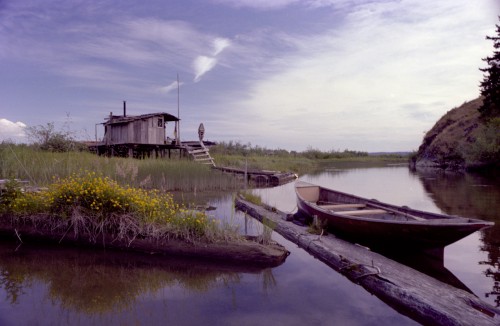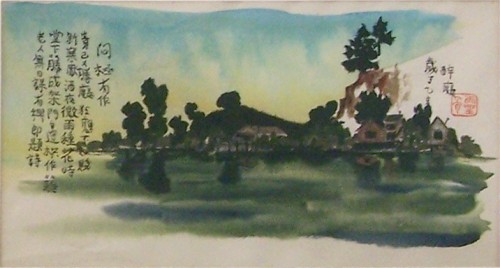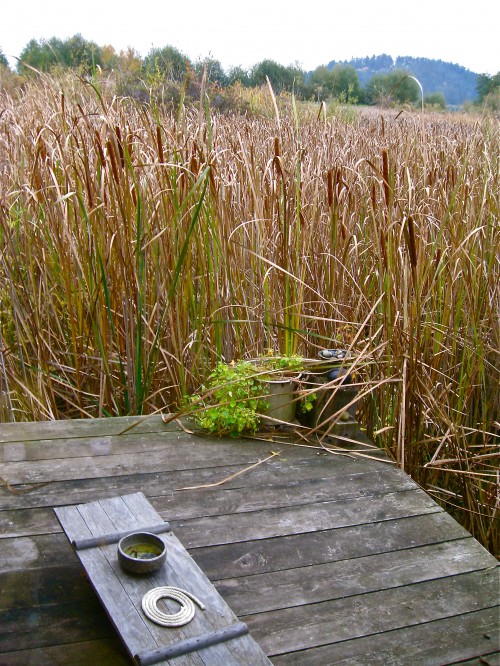New Book Captures Late Northwest Poet Robert Sund's Words

Robert Sund is our bard of the Skagit River, a singer of songs celebrating skunk cabbage, frogs, muddy water, ducks, and the rising tide. In the summer of 1973, the poet — who studied under Theodore Roetke at the University of Washington in the early 1950s — built a small dwelling on the pilings of a former fisherman’s shed in an estuary on the North Fork of the Skagit River. Access was only by boat and though his hermitage was a short paddle from La Conner and downstream from the active artists’ colony at Fishtown, he felt worlds away, “far, far back,” from modern society.
This removal gave Sund time and space to closely observe the rhythms of the natural world, as well as the fluctuations of his own thoughts and emotions, and he recorded these impressions in a series of thin, 26-page notebooks. The tidal marsh surrounding his shack, formed where the glacier-fed Skagit mixed with the saltwater of Puget Sound, provided him with endless inspiration for more than a decade of on-again, off-again residency.
“Out on the river you know you are in the midst of a great creation,” he wrote. “You see the old work and the new work side by side: the ancient migration routes of all the birds, and the slow building of silt and soil in the estuary.”
The choicest tidbits from Sund’s 75-plus journals have been extracted and lightly edited to produce a new volume of work from the well-loved poet, who passed away in 2001. Assembled by Sund’s close friends Tim McNulty and Glenn Hughes, Notes from Disappearing Lake: The River Journals of Robert Sund presents poem-like journal entries documenting life in the Skagit River estuary alongside spiritual insights, weather reports, and pithy celebrations of friendship and community.
“Robert was obviously not there to advise us,” explains McNulty, “but he was definitely looking over our shoulder as we worked on this project. We excerpted material that was pretty much intact and didn’t need to do much editing. Robert’s voice was rough and authentic and we wanted to keep it that way. Several friends have read these pieces and said, ‘This is like spending time with Robert again. ”
July, 1973
Snipe walking through the
flowers & grasses
picking worms & bugs out of
the mud —
Wren on the front porch
tiny feet
tick tick.
Robin, swallow
crow, seagull, heron
goldfinch, duck
blackbird . . .
Who needs a radio?
Song at morning
song at evening
and all day long …
This is the real news:
Local, regional, & world-wide.
Though he departed more than a decade ago, Sund’s unique voice, as expressed through his poems, painting, and calligraphy, has risen in repute since the 2004 publication of Poems from Ish River Country by prestigious publisher Shoemaker & Hoard, home of Gary Snyder, Robert Hass, and Wendell Berry. The Museum of Northwest Art’s successful Fishtown and the Skagit River exhibit in 2010 only heightened interest in the unique countercultural confluence of art, poetry, and spirituality that flourished in the Lower Skagit in the 1970s and ’80s.

The recent attention paid to this now-gone locality contrasts the original inhabitants’ desire to be left alone, hiding out in the marsh grasses where they could be free to pursue their alternative lifestyles.
“(The) burgeoning community (of Fishtown) reflected the larger national impulse towards going back to the land, living simply, and disengaging from chaotic political and social events,” Kathleen Moles writes in Fishtown and the Skagit River, the catalog for the MONA exhibit.
Sund had a deep interest in Chinese literature of the Tang and Sung dynasties — as many drawn to Fishtown did — and his shack provided him a private place to live like the hermit poets he read at night by lantern light. The seclusion, hardships and exposure to the raw elements of storms, tides and bird migrations were a forge for his poetic aspirations.
“A river mouth, in and of itself, exerts an influence on human consciousness that becomes manifest in music, literature, and art,” points out Skagit Valley novelist Tom Robbins in an essay in the MONA catalog.
Sund’s journals contained unvarnished etchings of that Skagit-flavored manifestation, and editors McNulty and Hughes’ work to unearth new material from their friend also revealed insights into the poet’s methods.
“Robert’s journals held his day-to-day notations; they’re perceptive, unique, sometimes dazzling, and of course poetic,” McNulty explains. “His observations offer keen insights into nature, record subtle personal reflections, and explore the experience of solitude in a wild, natural landscape. At the same time they’re often happy and joyful. The journals capture those aspects of Robert’s process, personality, and aesthetic in an immediate way. Chip and I had a great time exploring the journals and delighting one another with new discoveries.”

April 24, 1977 4 A.M.
In the excited mind
words fly.
The night is still, the water still ––
& suddenly, in the mind
(as on the night river
a beaver
breaks the silence)
the first ripple of a poem
swims almost invisible by the river bank.
Blades of grass standing in the river
feel the waves rise and
pass through them.
McNulty further says, “I see a marked contrast between the experience of Robert’s journals and the way we’ve become so locked into gadgets and digital media. The idea of Thoreau-like experiences, of being alone in stunningly beautiful landscape and following the mind’s drift on a daily basis…it can’t hurt.”
In light of this posthumous collection of Sund’s work, words he once wrote seem prophetic:
Maybe exalted gestures will be
retrieved in our time.
Maybe our grandchildren will go through
our trunks and boxes
and be amazed.
Top photo: Erik Ambjor; middle: Paul Hansen, untitled (Fishtown landscape); bottom: Christian Martin

